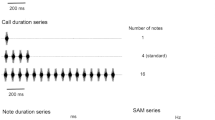Summary
In 17-year cicadas, only the male has a sound-producing apparatus. It consists of paired abdominal timbals, each driven by a specialized timbal muscle. Each muscle is innervated by a large timbal motorneuron. Having the largest axon in the auditory nerve, its central structure is readily elucidated with cobalt. The largest cell in the female auditory nerve is found to be a motorneuron that bears striking resemblance to the timbal motorneuron of the male. On the basis of their anatomy within the CNS, we consider these cells to be homologous, despite the fact that the female has no apparent timbal muscle. Cobalt-filling to the periphery reveals the target muscle of the female motorneuron to be one of the three tensor tympani muscles supporting the tympanum; these muscles are not found in the male. The evolutionary significance of these findings is discussed in terms of a possible loss of the sound-producing apparatus in females.
Similar content being viewed by others
References
Bacon JP, Altaian JS (1977) A silver intensification method for cobalt-filled neurones in wholemount preparations. Brain Res 138:359–363
Binet A (1894) Contribution à l'étude du système nerveux sous-intestinal des insectes. Jour de l'Anat et de la Physiol XXX, 449–580
Casserius J (160) De vocis auditusque organis historia anatomica sungulari fide methode ac industria concinnata tractatibus duobus explicata ac variis iconibus aère excusis. Ferrara F∘. 2 tractatus in 1 vol. Tab. I–XII + I–XII
Evans PD, O'Shea M (1978) The identification of an octopaminergic neurone and the modulation of a myogenic rhythm in the locust. J Exp Biol 73:235–260
Hagiwara S (1953) Neuromuscular mechanism of sound production in the cicada. J Physiol 3:284–296
Hagiwara S, Watanabe A (1956) Discharge in motorneurons of cicada. J Cell Comp Physiol 47:415–428
Matsuda R (1976) Morphology and Evolution of the Insect Abdomen. Pergamon, Oxford
Moore TE (1961) Audiospectrographic analysis of sounds of Hemiptera and Homoptera. Ann Entomol Soc Am 54:273–291
Myers JG (1928) The morphology of the Cicadidae (Homoptera). Proc Zool Soc Lond 365–472
Myers JG (1929) Insect Singers. Routledge, London
Ossiannilsson F (1949) Insect drummers. Opusc Entomol (Suppl), 10
Plotnikova SI (1969) Effectory neurons with several axons in the ventral nerve cord of Locusta migratoria. J Evol Biochem Physiol 5:339–341
Pringle JWS (1954) A physiological analysis of cicada song. J Exp Biol 31:525–560
Pringle JWS (1957) The structure and evolution of the organs of sound production in cicadas. Proc Linn Soc Lond 167:144–159
Reid KH (1971) Periodical cicada: Mechanism of sound production. Science NY 172:949–951
Simmons PJ (1977) Neuronal generation of singing in a cicada. Nature 270:243–245
Simmons PJ, Young D (1978) The tymbal mechanism and song patterns of the bladder cicada, Cystosoma soundersii. J Exp Biol 76:27–45
Tyrer NM, Altman JS (1974) Motor and sensory flight neurones in a locust demonstrated using cobalt chloride. J Comp Neurol 157:117–138
Vogel R (1923) Über ein tympanales Sinnesorgan, das mutmaßliche Hörorgan der Singzikaden. Z Ges Anat I. Z Anat Entw Gesch 67:190–231
Wohlers DW, Williams JLD, Huber F, Moore TE (1979) Central projections of fibers in the auditory and tensor nerves of cicadas (Homoptera: Cicadidae). Cell Tissue Res 203:35–51
Woodward TE, Evans JW, Eastop VF (1970) Hemiptera In: Waterhouse et al. (eds) The Insects of Australia, Melbourne Univ. Press, p 412
Young D, Hill KG (1977) Structure and function of the auditory system of the cicada Cystosoma saundersii. J Comp Physiol 117:23–45
Author information
Authors and Affiliations
Rights and permissions
About this article
Cite this article
Wohlers, D., Bacon, J. Sexual dimorphism of motorneurons: Timbal muscle innervation in male periodical cicadas and homologous structures in females. Cell Tissue Res. 209, 371–382 (1980). https://doi.org/10.1007/BF00234752
Accepted:
Issue Date:
DOI: https://doi.org/10.1007/BF00234752




